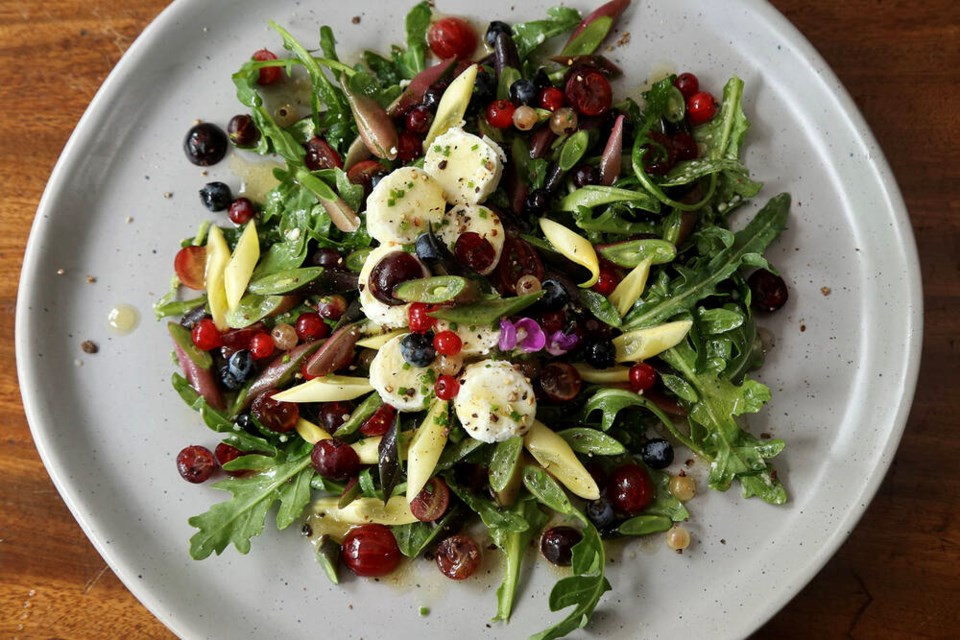A favourite ritual during my early morning garden walkabouts with veggie dog Dave, is sampling ready to eat snacks like peas, beans and berries.
At sunrise, before the heat of the day draws down their plump perfection, these tiny, perfect finger foods, covered still in the damp velvet of dawn, promised peak freshness and nutrition.
This is also the time of day when I plan our dinner menu. Oddly, but not surprisingly, the foods that come into season together, complement each other beautifully on the plate.
This week, on the heels of a deeply mulched heat wave, late-cropping sugar peas, bush beans, blueberries, beach strawberries, and myriad jewel tones of gooseberries and currants, were all ripe for the picking.
Assisted by Dave, too tiny to brave the lethal thorns of the gooseberry batch alone, I gathered the first crop of translucent red, purple, and green gooseberries, garnet jostaberries, red and white currants, and the loveliest offering of northern, low-bush blueberries we have enjoyed to date.
Next we pinched a generous helping of heirloom Red Swan, Canadian Wild Goose, Mont D’Or, and Purple Teepee beans from just 24 bush type plants snugged up down the centre of a single raised bed.
After struggling with short stakes and a sore back, I learned to plant bush beans closer to each other than recommended — in equally spaced (15 cm) clusters, rather than rows — and also flanked by a raft of pole beans on one side, and some other mounding type of offering like asparagus pea or sweet alyssum on the other.
Spaced thusly, bush beans hold each other up throughout the season, making harvesting easy and enjoyable.
Beans are among my favourite vegetables to grow, prepare and preserve. Heritage varieties suffer few pests, manage heat and water stress well if properly mulched, and offer optimal nutritional benefit and unadulterated DNA. Seed saving heirloom beans is simple; just let a dozen fully ripe pods dry on the vine, and use those beans seeds to plants next year’s crop.
Berries too are a relative breeze, once the bushes are established. On the plate, accompanied by some peppery wild arugula, tangy Salt Spring Island goat cheese, and a summery dressing of olive oil, white balsamic and lime juice, beans and berries sing.
To this beautiful mess of a salad, I added a small piece of freshly caught grilled sockeye salmon. Poached and sliced chicken breast, a crab or fish cake, grilled prawns, a grilled hamburger patty, crispy cubed tofu, or any other protein would be equally delicious.
Better still than the privilege of growing and preparing this colourful organic feast, is the complex phyto-chemical nutrition contained in each and every bite.
Fresh green, pink, yellow and purple beans are rich in fibre, protein, vitamins C, A, K, B6, E and niacin and thiamin, and contain magnesium, calcium, iron, phosphorous, potassium and zinc. Beans also contain resistant starch — a healthy carbohydrate that feeds good gut bacteria.
Gooseberries and jostaberries are low in sugar and calories, but packed with nutrients like vitamins C, B5, B6, plus copper, manganese and potassium. Flavonols like quercetin are linked to cancer-fighting, stroke-reducing, and antiviral effects. Compounds found in pigments are associated with eye and urinary tract health, and improved memory.
Powerhouse currants, both fruit and leaves, offer full body and brain health benefits too many to mention, most notably perhaps for the eyes. We freeze them for use in smoothies, reduction sauces and low-sugar desserts.
Bush beans and berries are low-maintenance, low barrier to entry food plants that can be grown almost anywhere, including in pots on a sunny porch or doorstep.
Laura Marie Neubert is a West Vancouver-based urban permaculture designer. Follow her on Instagram @upfrontandbeautiful, learn more about permaculture by visiting her Upfront & Beautiful website or email your questions to her here.
For a taste of permaculture, watch the video below:



